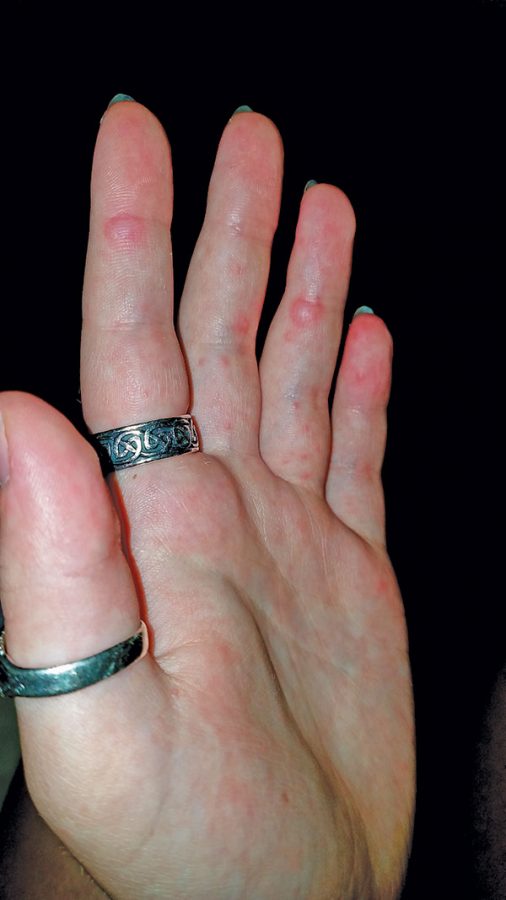Campus plagued with hand, foot and mouth disease
A hand of the afflicted
Hand and Foot and Mouth, oh my!
One of the downfalls of being a part of a tightly-knit community such as the one on campus is that you essentially live in a large petri dish. People from all over the country have accumulated on our campus, bringing with them a slew of new bacteria to share with their new friends.
That is precisely what has been happening these first couple weeks of the semester. Hand Foot Mouth Disease (HFMD) spread across the campus as well as flu and strep-like illnesses. The virus was widespread and all the residential halls were affected.
What is HFMD? Common symptoms include sore throat, fever, reduced appetite and the tell-tale red (then often blistering) rash on the host’s hands, feet and in their throat, often spreading to other regions as well.
One student who got a rather extreme case said, “My feet were so bad I couldn’t walk… my hands… my ribs… my face… my back… it was genuinely unpleasant.”
Another sufferer put it this way: “I couldn’t really pick things up; it hurt so much… to yawn or like, open my mouth all the way.
Others reported similar misery. One said that he had “a fever, a really, really bad sore throat… it started with a really really bad headache and then it kind of progressed with nausea… I was at 103.8 for like, half a day. I was bedridden.”.
Typically, this nasty disease is seen in daycares and is similar to chicken pox in that you cannot contract it again, and it is worse if you get it as an adult. It is spread through close personal contact with the afflicted or with contaminated objects that they have used. Once you get it, the only real cure is to ride it out and just try to stay comfortable. “It was pretty awful, and I wish there was something to help out with it, but no, there isn’t,” said one student who went to see a doctor after falling ill.
In many cases, the contagious factor will linger up to two weeks after symptoms have disappeared. To make matters worse, some adults don’t actually experience symptoms but can still be a carrier of the virus and spread it to others for that same two-week period.
As most students know, there is no longer a health office on campus. According to Associate Dean of Students Michele Whitmore, this difficult decision was made after a survey of students concluded that the facility simply was not being utilized enough to justify funding.
However, NVU-Johnson is partnered with the Community Health Services of Lamoille Valley (CHSLV) and students are able to access medical care in Morrisville at the family health center. For students without transportation, shuttles are provided three times a day.
With this most recent outbreak, however, the university has been examining ways to make care more available to students.
Whitmore says that nothing as serious as this has broken out since medical services have been moved off campus, but that this outbreak has sparked some conversation about student care options to be better prepared for events like this in the future.
Inventory is also being taken of all hand sanitizing stations around campus, and they are being checked and refilled more frequently. Some might be added in the future as well, in places that currently do not have none.
How do we stay healthy in the meantime? The best defense, as we’ve seen on the posters that were put up around campus and talked about in floor meetings, is simply to wash your hands and avoid contact with sick individuals.
If you do get it, you are strongly encouraged to excuse yourself from classes, especially if you have a fever. Whitmore recommends a common sense approach: “Making good choices all around: sleep, nutrition, listening to your body and taking good care of yourself.”

Sophomore, Journalism
Grew up in Salisbury, NH
Fall 2018 - Present
The closest I have come to fame so far is once, at a Weird Al concert, he went...




